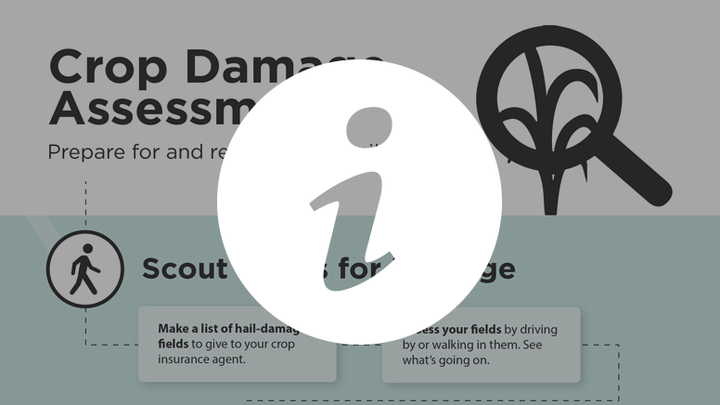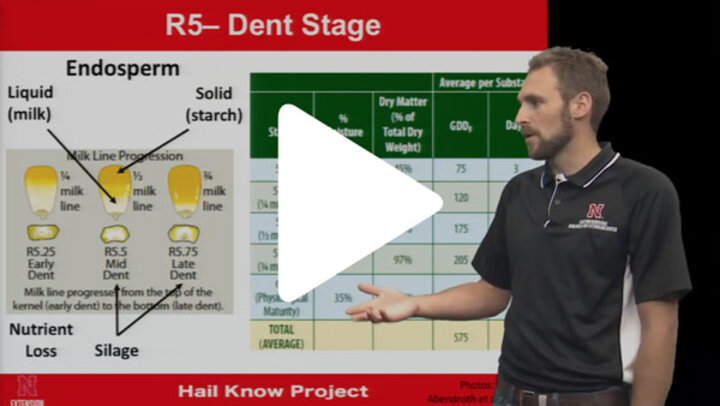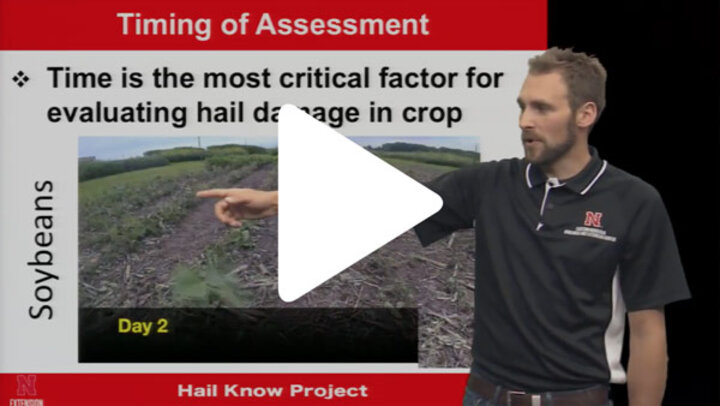
How To’s of Crop Damage Assessment
Identify the plant growth stage. If it’s difficult to determine, use planting date and growing degree days as a guide.
Early Season Must-Do's
A number of factors should be considered when evaluating early season crop damage.
In-Season Must-Do's
Evaluating and recording crop progress each week will be helpful in determining the extent of crop damage.
Late Season Must-Do's
Use this time to evaluate production practices used and plan for next year’s crop.

Infographic: Crop Damage Assessment
If your field was on the receiving end of a hail-producing storm, you may have a lot of questions. What should I do first? When should I scout my fields for damage? Who should I contact and when? Find out the answer to these questions and more in this infographic.

Video: Hail Damage Assessment
Be confident in accurately assessing hail damage to crops and the potential for regrowth and recovery or the need to replant with research-based information from Nebraska Extension.

Video: 7-Day Time Lapse of Corn Recovery from Hail Damage
As part of a 2015 University of Nebraska-Lincoln research project on the effects of hail on crop development, Justin McMechan used time lapse photography to show how V4 corn recovered during the seven days post hail. McMechan and Roger Elmore, Extension Cropping Systems Specialist, used a hail machine.

Video: Hail Damage Evaluation and Management in Corn
Production loss estimates in corn from hail damage is a critical first step for determining the need to replant or to make adjustments on future inputs. Regardless of crop development stage, it is critical to wait 7-10 days to allow the crop to respond for proper evaluation. Production loss estimates by the Federal Crop Insurance Corporation in corn may include remaining plant stand, defoliation and direct losses from ear damage depending on the stage of development. Additional losses and quality issues can occur with fungal infections so continued scouting of hail damage fields is important. Be sure to contact your crop adjuster before making any management decisions on a hail damaged crop. Justin McMechan, University of Nebraska Crop Protection and Cropping System Specialist.

Video: Hail Damage Evaluation and Management in Soybean
Estimating yield losses in soybeans from hail damage is a critical first step for determining the need to replant or to make adjustments on future inputs. As with any hail damage in row crops, it’s critical to wait 7-10 days to allow the crop to respond for proper evaluation. Production loss estimates by the Federal Crop Insurance Corporation in soybean can be a combination of remaining plant stand, nodes cut or broken, and defoliation. Beginning maturity and full maturity stage soybeans are evaluated based on the seed count method. Be sure to contact your crop adjuster before making any management decision on a hail-damaged crop. Justin McMechan, University of Nebraska Crop Protection and Cropping System Specialist

MEET THE TEAM

This project was funded by a USDA National Institute of Food & Agriculture Smith-Lever Special Needs Grant with matching funds from the University of Nebraska–Lincoln.







